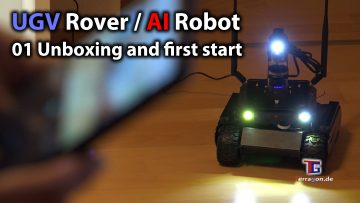
Unboxing and First Test of the UGV Rover AI Robot
The UGV Rover, an impressive AI-powered robot, has arrived for testing. This blog post details the unboxing experience and initial impressions of this cutting-edge device.
Packaging and Delivery
The UGV Rover arrived swiftly from China via DHL Express, securely packaged to prevent any damage during transit[1]. Upon opening the box, we found the pre-assembled rover nestled snugly inside, accompanied by a variety of accessories.
What’s in the Box
The package includes the pre-assembled UGV Rover and a collection of accessories. It’s worth noting that batteries are not included and must be purchased separately. For optimal performance, Samsung batteries are recommended[1].
Hardware Overview
Main Components:
- Pre-assembled UGV Rover
- Jetson Orin Nano (4GB version)
- Dual controller setup
The UGV Rover boasts a sophisticated dual-controller configuration. The base controller manages movement and basic robotic tasks, while the Jetson Orin from NVIDIA handles the artificial intelligence operations[1].
Customization Options:
Interestingly, customers can opt for a Raspberry Pi instead of the Jetson Orin, which may alter the robot’s appearance slightly.
Battery Installation
Installing the batteries requires attention to detail. The battery compartment accommodates flat-pole batteries, so it’s crucial to align the positive and negative terminals correctly[1].
First Start-Up and Connectivity
After installing the batteries, the initial start-up process is straightforward. Users need to establish a network connection by following the instructions provided on the manufacturer’s website. Once connected, you’ll be able to view the camera feed and control the robot using a phone, tablet, or computer[1].
Mobility and Sensors
The UGV Rover demonstrates impressive maneuverability:
- Forward and backward movement
- Side-to-side motion
- 360-degree rotation on the spot
Sensor Suite:
- Blue LiDAR scanner for 2D mapping
- Camera system with depth perception for 3D scanning
- LED-illuminated standard camera
These sensors suggest exciting possibilities for creating both 2D and 3D maps in future applications[1].
Conclusion
This initial test of the UGV Rover reveals a well-designed, versatile AI robot with promising capabilities. Future blog posts will delve deeper into the software aspects and explore the full potential of this intriguing device.
Stay tuned for more updates on the UGV Rover and its AI-powered features!
 1 comment
1 comment






